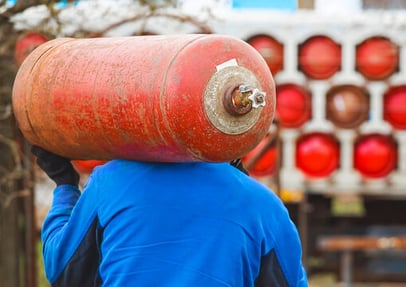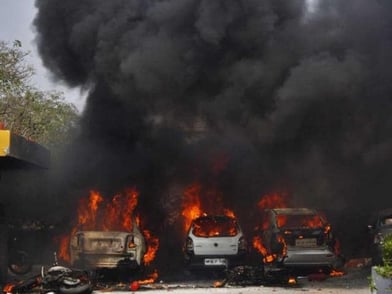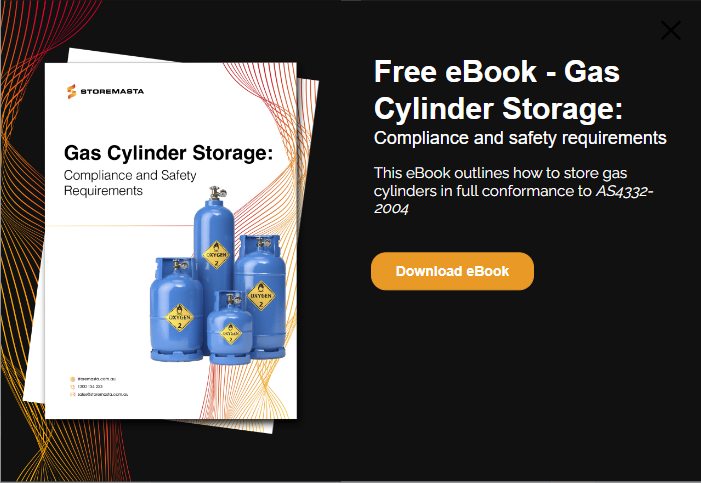With the increased supply of oxygen cylinders worldwide due to the COVID-19 pandemic, more people than ever are handling and storing oxygen cylinders. While oxygen is used for first aid and medical assistance, it is also essential for an array of applications including laboratory tasks, welding and cutting, food preservation and packaging, water treatment, chemical production and steel works. However, it’s important to remember that oxygen is a very reactive gas and has the potential to cause or intensify fires when in contact with incompatible substances or heat. Here, we outline the risks involved with using oxygen cylinders and discuss how you can safely store O2 cylinders in the workplace.
What Are The Risks Associated With Oxygen Cylinders?
Oxygen cylinders are vessels that contain oxygen under pressure. When the cylinder is depleted of the gas, the pressure gauge will gradually fall off. While oxygen is classified as a Class 2.2 (5.1) non-flammable, oxidizing gas, cylinders can cause serious injury and damage if they are not handled and stored correctly.
As the air we breathe contains around 21% oxygen, even a small increase to the oxygen levels in an environment can be enough to create a potential hazard.
Oxygen enrichment is the term used when extra oxygen is leaked into the atmosphere. In an oxygen rich environment, there is the increased potential for fires to occur as the extra oxygen allows fires to ignite easier and burn hotter. It also creates a situation where fires are almost impossible to put out.
Workers are extremely vulnerable in an oxygen enriched atmosphere, with the potential for hair and clothing to easily catch fire and cause 2nd and 3rd degree burns — which are often fatal.
1. Leaking O2 Gas Cylinders
As outlined in the previous section, oxygen gas leaks pose a very real threat to workers and their work environment. A leaking gas cylinder can rapidly create a potentially dangerous oxygen enriched environment, especially in confined spaces and rooms with poor ventilation.
How Can An Oxygen Leak Occur?
The mishandling and lack of maintenance for oxygen cylinders can cause an oxygen leak. Cylinders and equipment should be inspected regularly for leaks and serviced by qualified staff or contractors.
 Gas cylinders being inspected
Gas cylinders being inspected
Oxygen Bottle Leaks May Be Caused By:
- Damaged hoses, pipes and valves
- Worn fittings and loose connections
- Leaving valves open when not using the cylinder
- Using too much oxygen when welding or flame cutting
- Accidentally opening the valve
2. Contacting Incompatible Materials and Gases
When materials such as oil, grease, certain metal and plastics come into contact with pure oxygen under pressure, they can react explosively or spontaneously catch on fire.
Fires and explosions have been caused by oxygen contacting:
- O-rings and gaskets containing rubber or petroleum-based substances
- Metal components
- Lubricants
- Tape
- Incorrect pressure hoses and regulators
Workplaces should only use materials and components that have been tested and certified safe for use with oxygen gas to avoid the potential for an explosion of fire.
3. Incorrect Use Of Oxygen Gas
Oxygen cylinders have caused fires, explosions and serious injuries when workers have incorrectly substituted oxygen for compressed air or other gases. Organisations should always ensure that the equipment used in your workplace is specifically designed for oxygen service.
Some examples of the incorrect use of oxygen include:
- Using oxygen to drive pneumatic tools instead of compressed air
- Inflating vehicle tyres
- Starting diesel engines
- Attempting to increase oxygen levels in a confined space
If you are unsure about your equipment’s compatibility with oxygen, you should always check with the supplier.
Remember: AS4332-2004 - The storage and handling of gases in cylinders clearly states that gases must only be used for the purpose for which they were intended.
4. Careless Handling Of Oxygen Cylinders
Explosions and catastrophic fires can occur when there is the careless handling of oxygen cylinders in the workplace. If staff accidently expose cylinders to heat or drop oxygen cylinders while they work, there is a chance that the bottle will explode. Impact and heat can adversely affect O2 cylinders which can cause serious damage to both people and property.
It’s a requirement under AS4332-2004 that workers must fully understand the risks and hazards of using oxygen gas in cylinders and be trained in safe handling and storage methods.
 Careless handling of gas cylinders
Careless handling of gas cylinders
Real-Life Incidences Of Oxygen Cylinder Explosions
To illustrate the dangers associated with handling and storing oxygen cylinders, we outline just four recent workplace disasters that have caused irrevocable damage. These real-life examples highlight how crucial it is for workplaces to properly manage their compliance and safety obligations.
Gas Bottle Fire, Melbourne 2017
A gas bottle containing oxygen and acetylene was being transported through Bayswater, Victoria when it caught on fire.
The bottle was being transported in a fully enclosed toolbox in the back of the ute. Additional gas bottles were also left on their side and unsecured in the back of the ute. It was reported that the canopy was too low to keep the bottles in an upright position.
While on the road, the acetylene vapour and air mixed and exploded in the back of the vehicle. The gas bottle fire caused extensive damage to the driver, the vehicle and the surrounding environment. A worker was permanently disabled by the explosion, while fire damaged nearby cars and overhead powerlines.
WorkSafe Victoria reported that the company was convicted and fined $300,000 for the incident.
Oxygen Tank Explosion, Baghdad 2021
An oxygen tank explosion at a Baghdad hospital was responsible for killing at least 82 people and injuring another 110.
Reuters reported that patients at the COVID hospital had to escape the flames by leaping through windows. The incident appeared to be due to negligence, with an investigation into the matter ordered by cabinet.
Oxygen Cylinder Explosion, India 2021
An exploding oxygen cylinder killed at least three people and injured eight at a KT Filling Station in Chinhat.
It was believed that employees of the oxygen plant were attempting to refill an oxygen cylinder when the explosion took place.
The Indian Express reported that the exploded cylinder had a technical fault and was not capable of holding the full pressure of the oxygen when it was filled. The cylinder's intended use was for medical oxygen for a COVID patient.
Oxygen Packing Plant Explosion, Brazil 2021
Four people were killed after an explosion at a Brazilian oxygen packing plant in Fortaleza in north-eastern Brazil.
Hazard Ex reported that the factory was responsible for filling oxygen cylinders with the gas so they could be distributed to hospitals across Brazil.
 Oxygen Cylinder Explosion
Oxygen Cylinder Explosion
Safety Precautions For Oxygen Cylinders
Oxygen cylinders must be handled with extreme care to avoid risk in the workplace. It is important that O2 cylinders are kept on a purpose-built gas bottle trolley while they are being used at a workplace.
Safety precautions for oxygen cylinders include the following essentials:
- Keep cylinders upright and restrained at all times: cylinders can easily fall or be knocked over
- Open valves slowly: rapid release can cause frictional heat and cause a fire/explosion
- Keep cylinders valves and connections clean: dust, dirt, sand, oils, and greases are potential fire hazards
- Only use fittings, lubricants and components certified safe for use with O2: incompatible fittings can cause fires and explosions
- When work halts close cylinder valves — don’t nip or kink a hose to arrest the gas flow
- Keep O2 cylinders away from flammables and toxic gases: contacting flammables and incompatible toxic gases can create catastrophic fires, explosions and chemical reactions.
- Wear proper clothing and PPE: clothing containing oil and grease residues can ignite
How Should You Store O2 Cylinders?
Oxygen cylinders should be stored according to the guidelines of AS 4332-2004 - The storage and handling of gases in cylinders. Some of the requirements include:
- Storing cylinders upright with attachments removed and valves closed
- Ensuring O2 cylinders are individually restrained (chains/safety straps) inside a secure Class 5.1 - Oxidising Agent Gas Cylinder Store.
- Locating the gas bottle cage outside, away from heat, ignition sources, combustibles, refuse, and vegetation
- Segregating oxygen from Class 2.1 Flammable Gases and Class 2.3 Toxic Gases by at least 3metres
- Ensuring cylinder valves are protected at all times
Strategies For O2 Cylinder Storage
If you use oxygen and other compressed gases at your worksite, why not download our FREE eBook; Gas cylinder storage: Compliance and safety requirements? This resource will help you learn how to safely store O2 cylinders in the workplace and give you a broader understanding of how to manage the risks and hazards associated with O2. This free eBook also introduces our dangerous goods risk management methodology - IDENTIFY - ASSESS - CONTROL - SUSTAIN which you can implement into your workplace. Get it now by clicking on the image below.Joining the team as a Dangerous Goods Storage Consultant, Melissa Hampton became Storemasta's Marketing Manager in late 2021. With extensive knowledge and experience in chemical compliance, Melissa is responsible for leading the Marketing team and helping shape their marketing strategy. In her spare time, you can find Melissa hiking, swimming and enjoying the great outdoors in beautiful north-west Tasmania.
